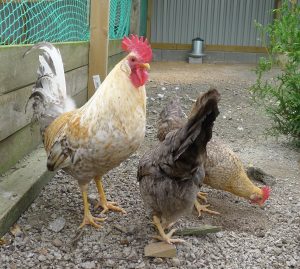Overview
The Norwegian Jaerhon is the only chicken breed that originated in Norway. The breed was first created in Norway in the 1920s by breeding local stock that was found along the Southern Atlantic coast of Norway. They are very resistant to cold as their origin country is freezing for most of the year, which makes them good chickens for cold climates. Despite being around for nearly 100 years, the breed was only first brought to America at the beginning of this century.
This breed is not recognized by major poultry associations so there are no standardized appearances. This is a self-sexing breed, therefore, you can identify the sex from their appearance.
Males weigh around 1.7kgs (3.8lbs) and females weigh around 1.6kgs (3.2lbs).
Eggs
Size
Large-sized eggs
Color
Creamy white eggs
Production per year
215 eggs per annum
When do they start laying eggs?
From 16 weeks old
Characteristics
Temperament / Are they good as pets?
Yes, they’re small and friendly so would make great pets as long as you have lots of space for them to roam freely in.
How do I tame these chickens?
Picking your chicks up and holding them is the most effective way to tame chickens. If you don’t want to pick them up you can always try feeding them out of the palm of your hand instead.
How many do I need to buy?
Chickens don’t do well by themselves and need at least one other pal, but we recommend that you have at least 6 chickens.
How much space do they need?
This breed likes to have lots of space to be active in, therefore, you’ll need at least 250 square feet per chicken.
Will they mix with my other chickens?
Yes, this breed is friendly and should mix well with other chickens. Make sure to watch out for bullying or overcrowding as this can make chickens aggressive.
Appearance
This breed has a small body with white earlobes and a single red comb. The most common colors of plumage are dark brown with yellow and light brown with yellow. They have a yellow beak and yellow legs that are clean of feathers.

Feeding
What should I feed them?
When your chicks hatch they need refined food that they can eat with their small beaks, therefore, you should give them growers mash. Growers’ mash is packed with the nutrients and good stuff that your chicks will need in order to grow big and strong.
Once they’re a bit older, at 6 weeks, they can be given chicken pellets. This is just regular chicken feed compacted into pellets, usually with a protein content that’s between 15-16{cfcd481556a8b43fba6af451761032bd323e94372a0c1e607}.
At 14 weeks you should gradually introduce layers mash or layers pellets, this has between 15-17{cfcd481556a8b43fba6af451761032bd323e94372a0c1e607} protein content and contains special ingredients that will help your girls with egg production.
How much should I feed them?
Chickens can eat anywhere between 2.9oz (80g) to 4.2oz (120g), but on average eat around ¼ of a pound (113g) of feed a day. As this breed is lighter than most they’ll probably need a bit less than this. Start by feeding them a little less than this and then adjust based on their consumption.
What can’t they eat?
If you take a look at the feed section of our page there is a detailed list of everything you should and shouldn’t feed your chickens. The main two offenders are beans and chocolate. This is because this food contains phytohemagglutinin and theobromine, which can cause fatalities if they’re ingested by chickens. Any food that is way past its consume by date or that has gone bad shouldn’t be fed to chickens because of the bad bacteria.
What do I need to keep chickens?
The first thing that you should buy when preparing for your new chickens is a coop; the coop should have around 11 square feet per chicken, but make sure it’s not too large otherwise they’ll have problems keeping themselves warm during the winter. Inside the coop, there should be a perch for each bird to sleep on during the night and wooden laying boxes for them to lay their eggs in.
To keep your chickens safe from predators you’ll need a fence around and over the coop. Sink the fence at least 8 inches into the ground, this prevents predators from digging under the fence to access the coop. There should also be a fence around their exercise area, the area needs to be at least 250 square feet per chicken. Chickens need water, therefore, you’ll need to buy a water container that they can’t tip over or stand in. Keep this container away from sunlight as chickens prefer cool water.
If you don’t have any grit in the area where you are keeping your chickens then you’ll need to buy some and keep it close by so that they can help themselves as they please.

